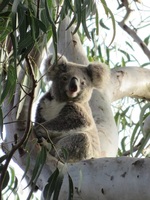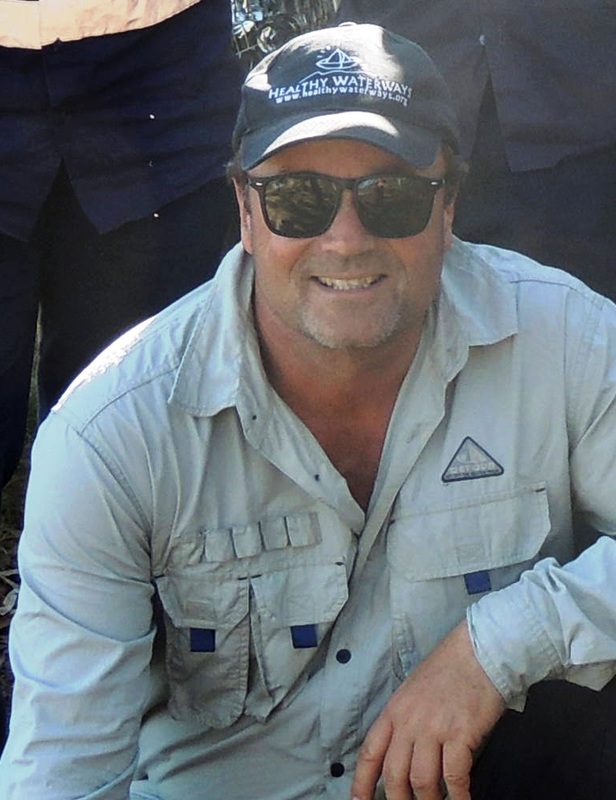 Clontarf resident; "Lily the Koala"
Clontarf resident; "Lily the Koala" The destruction and degradation of koala habitat in our region means every piece of Eucalypt forest left needs to be looked after. It’s time we all helped out; a small contribution from each of us can make a big difference to our koala population and wildlife in general This article outlines some of the issues our local koalas are facing and some positive actions that anyone in the community can provide assistance with. If you can spare a few hours here and there you can make a big difference to the health of our environment.
A recent presentation from the Moreton Bay Rail Link Koala team (Endeavour Veterinary Ecology) summarised some of the impacts of this major infrastructure project on our local koala population. Over 400 koalas were identified over the past two years. Incredibly there was a significant mortality rate during the same period – nearly 200 deaths, many linked to attacks by wild dogs. There would be little doubt that the removal of significant tracks of koala habitat through development has exposed the marsupials to attacks on the ground.
This reduction in suitable habitat means koalas have to move between remnants of Eucalypt and are then vulnerable to attacks from dogs and exposed to the dangers of traffic.
Eucalypt forest not only provides shelter and food for koalas but provides habitat for many species of mammals, birds, reptiles and insects. They are a key to providing biodiversity, buffering our wetlands and giving local people the opportunity to see a koala in the wild. Eucalypt grows in areas of the region which have limited exposure to floods. Unfortunately this type of land is suitable for development and consequently the majority of this habitat has been cleared. Functioning Eucalypt forest in our own Peninsula area including the catchment area of Moreton Bay has become a limited commodity.
There are still patches of Eucalypt around Hays Inlet but they are generally in poor health or fragmented so they are not capable of supporting large numbers of koalas. Fortunately, there is the potential to enhance the health and coverage of these “Koala-friendly” trees and provide more food and shelter for our threatened marsupials. This can be achieved in two ways:
· Remove weeds which smother saplings and cause bushfires to burn at higher temperatures. The increased temperature kills native flora including Eucalypts, Melaleuca and Casuarina which opens up the soil to weed growth.
· Propagate and plant koala friendly trees wherever the soil and topography is appropriate. It is hard work and labour intensive but the rewards are worth it.
Recent work by our Green Army team at Clontarf has revealed what’s possible around Hays Inlet. Whilst it is important that the Council, State and Federal Government provide the resources necessary to rehabilitate our remaining natural habitat; it is also just as important that the community gets involved as well. Our government agencies alone cannot address the issue. We need volunteers for our local bushcare groups and conservation organisations to get stuck into the ground work of removing weeds, laying mulch, tree planting and looking after our environment in general. This type of direct action is needed to support initiatives like the Green Army Project at Hays Inlet. Improving the capacity of our regions remaining Eucalypt habitat in order to sustain koalas and wildlife should be a priority for members of the local community along with the support of government agencies including the Federal Green Army Program, the State Government and the Moreton Bay regional Council.
If you would like help or to know more about volunteering with the Redcliffe Environmental Forum – just click on the “contact” page on this blog.
A recent presentation from the Moreton Bay Rail Link Koala team (Endeavour Veterinary Ecology) summarised some of the impacts of this major infrastructure project on our local koala population. Over 400 koalas were identified over the past two years. Incredibly there was a significant mortality rate during the same period – nearly 200 deaths, many linked to attacks by wild dogs. There would be little doubt that the removal of significant tracks of koala habitat through development has exposed the marsupials to attacks on the ground.
This reduction in suitable habitat means koalas have to move between remnants of Eucalypt and are then vulnerable to attacks from dogs and exposed to the dangers of traffic.
Eucalypt forest not only provides shelter and food for koalas but provides habitat for many species of mammals, birds, reptiles and insects. They are a key to providing biodiversity, buffering our wetlands and giving local people the opportunity to see a koala in the wild. Eucalypt grows in areas of the region which have limited exposure to floods. Unfortunately this type of land is suitable for development and consequently the majority of this habitat has been cleared. Functioning Eucalypt forest in our own Peninsula area including the catchment area of Moreton Bay has become a limited commodity.
There are still patches of Eucalypt around Hays Inlet but they are generally in poor health or fragmented so they are not capable of supporting large numbers of koalas. Fortunately, there is the potential to enhance the health and coverage of these “Koala-friendly” trees and provide more food and shelter for our threatened marsupials. This can be achieved in two ways:
· Remove weeds which smother saplings and cause bushfires to burn at higher temperatures. The increased temperature kills native flora including Eucalypts, Melaleuca and Casuarina which opens up the soil to weed growth.
· Propagate and plant koala friendly trees wherever the soil and topography is appropriate. It is hard work and labour intensive but the rewards are worth it.
Recent work by our Green Army team at Clontarf has revealed what’s possible around Hays Inlet. Whilst it is important that the Council, State and Federal Government provide the resources necessary to rehabilitate our remaining natural habitat; it is also just as important that the community gets involved as well. Our government agencies alone cannot address the issue. We need volunteers for our local bushcare groups and conservation organisations to get stuck into the ground work of removing weeds, laying mulch, tree planting and looking after our environment in general. This type of direct action is needed to support initiatives like the Green Army Project at Hays Inlet. Improving the capacity of our regions remaining Eucalypt habitat in order to sustain koalas and wildlife should be a priority for members of the local community along with the support of government agencies including the Federal Green Army Program, the State Government and the Moreton Bay regional Council.
If you would like help or to know more about volunteering with the Redcliffe Environmental Forum – just click on the “contact” page on this blog.

 RSS Feed
RSS Feed
